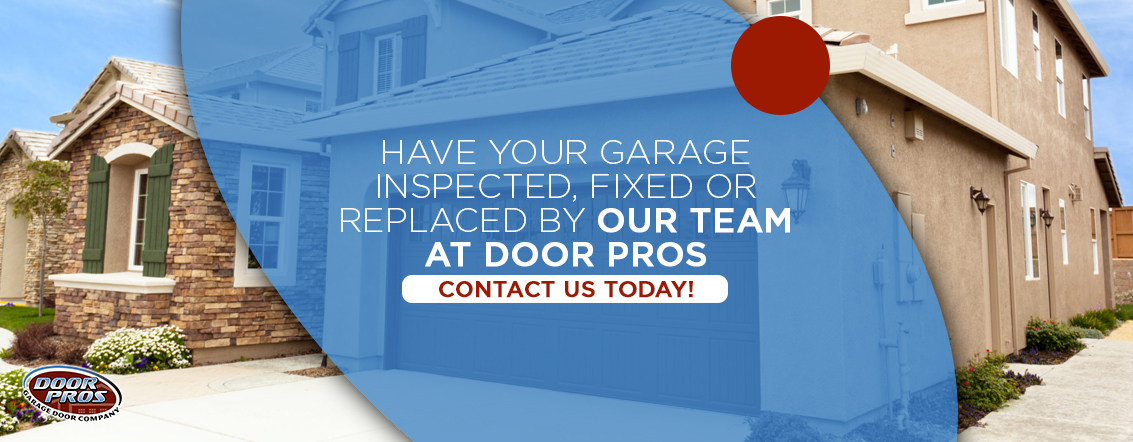Why Won’t My Garage Door Go Up?
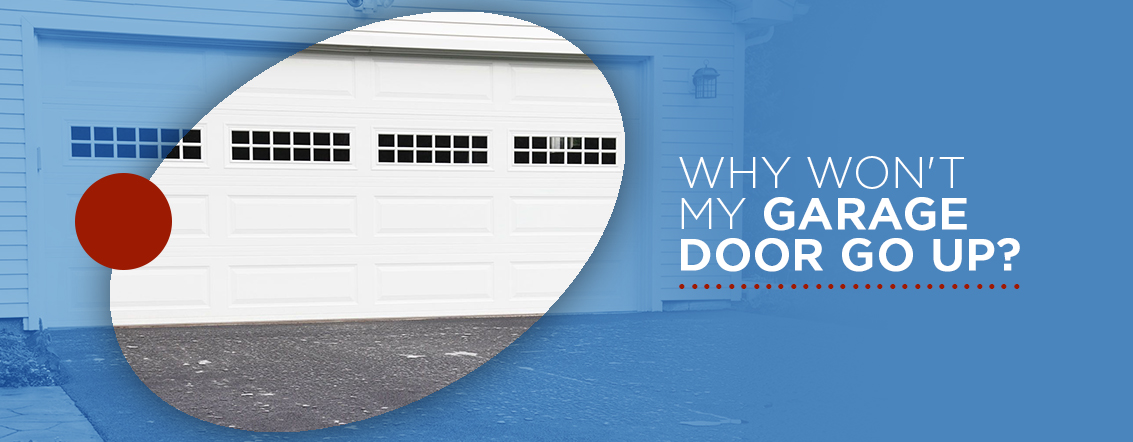
There are many possible reasons why your garage door is not opening properly. If your garage door opener does not work or the door doesn't open all the way, you may need to replace part or all of it. To repair a garage door that's not opening, contact a professional garage door company that understands your door manufacturer.
Before you learn how to fix a garage door opener, you have to understand why your garage door won't open. Some of the most common reasons why your garage door won't open include:
1. Photo Eye Is Out of Alignment
The photo eye is the safety sensor on the garage door. Its job is to detect a person or object in the way of the door. If you hear a clicking noise and see a light flash from the garage door opener, there may be an issue with the photo eye.
Since photo eyes are sensitive, there are several reasons why the photo eye could be out of alignment. Try these remedies for realigning photo eyes:
- Clean the photo eye: Dirt and dust can sometimes clog the sensor and freeze the garage door in place. As a safety feature, the photo eye is programmed to instantly respond to any obstruction in the path of the garage door. If the photo eye recognizes anything in its way — even as small as a speck of dust or debris — the garage door will stay open. Clean the photo eye with a cloth or a tissue and test the garage door.
- Remove larger obstructions: The photo eye involves two pieces that align face-to-face across each side of the garage door. A pea-sized LED laser beam is sent from one end to the other, detecting people or objects in the path of the garage door. If something is in the way, the garage door won't open. Remove the obstruction from the path of the photo eye. If the object caused damage to the photo eye, call in a service technician to replace the hardware.
- Inspect the alignment of the two pieces of the photo eye: When the photo eye is misaligned, each piece of the eye misses the LED laser beam from the other. The photo eye can only open or close the garage door if each piece of the photo eye receives the LED laser beam from the other side. Photo eyes can become misaligned by excessive use or physical pressure. Use a level to make sure both of your photo eyes are installed at equal heights.
- Check the wiring of the photo eyes: The photo eye is about four to six inches off the ground for most doors. The cord attached to the eye could become damaged due to harsh rainstorms, hungry pests and excessive use. Check the cord attached to the eye for water damage or rips. If the wires are broken, you'll have to replace the photo eye sensor.
- Check the LED light on each side of the sensor: If the lights are lit, check to make sure the photo eye isn't dirty. If one light is flickering or off, the photo eye could be damaged. Move the malfunctioning sensor with your hand to see if the light changes. Adjust the pivot bracket to try to revive the LED sensor light. Once the light is back on, tighten the sensor back in place.
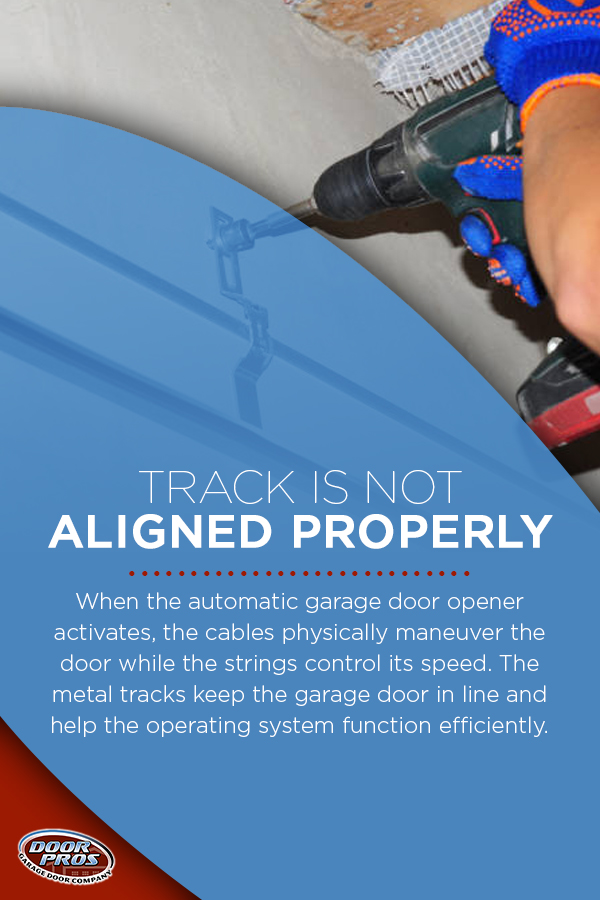
2. Track Is Not Aligned Properly
When the automatic garage door opener activates, the cables physically maneuver the door while the strings control its speed. The metal tracks keep the garage door in line and help the operating system function efficiently. The tracks of the garage door must be straight and even at all times for the garage door to open and close.
A crooked door that jerks around or makes grinding noises could have fallen off the track. Over time, as misalignment worsens, the garage door could stop working.
To assess whether the garage door track is misaligned:
- Be gentle with the door: If your garage door won't fully open, forcing the door open or closed could damage the door. Dealing with the garage door forcefully could bend the vertical tracks and pop the door out. Protect yourself and your property by carefully trying to maneuver your door.
- Use your eyes and ears: Make sure the door is gliding smoothly along the track. Check the track for bends, gaps or obstacles. Listen to and watch the door's path along the track. If you hear areas of friction or see jams along the track, a misaligned track could be the issue.
- Adjust the track yourself: Before making any adjustments to the garage door track, check that the door is completely closed. For an extra safety measure, turn off the automatic feature on your garage. To realign the garage door into the track, loosen the screws that hold the track to its frame. Gently tap the track back into its proper position and tighten up the screws again. The overhead track should be the same distance away from the door as the wall track.
- Make an appointment with your garage door company: Call in a professional garage door inspector to examine your garage door and put it back on track. They will touch up the tracks and rollers by cleaning off the dust and debris. They will also check and tighten any of the track's loose hardware.
Try to fix a misalignment before it becomes an issue. When you inspect your garage door each year, look for loose nuts and bolts around the track. Spray a silicone-based lubricant on the track and the hardware to prevent rust.
A slight misalignment on the track could slow down the movement of the garage door. You would hear a grinding or whining noise as the garage door moves if any of the tracks are bent. If your garage door doesn't open or close, the track may be broken. In that case, you may need to get your garage door system replaced.
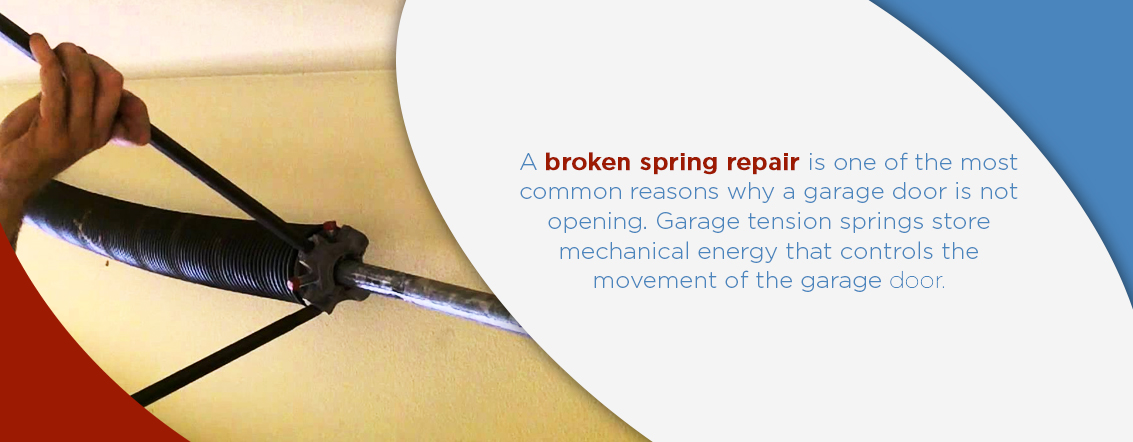
3. Broken Tension Springs
A broken spring repair is one of the most common reasons why a garage door is not opening. Garage tension springs store mechanical energy that controls the movement of the garage door. Wear and tear could weaken the tension springs, which could lead to the garage door not working.
Garage door springs offset the weight of the garage door to open and close the door smoothly. These springs are featured in both manual and automatic garage door systems. Two torsion springs run horizontally over the width of the door, while two extension springs lift and lower the door along the track.
The tension springs on the garage door could be broken because of:
- Wear and tear: Each spring is rated according to its number of cycles. Once a tension spring has used up all its cycles, it stops working. Springs that have been used excessively are known to snap abruptly while the door is in motion. In some cases, a spring breaks before its projected expiration date.
- Rust: A development of rust on the tension springs increases friction on the coils as it moves. To prevent your tension springs from breaking due to rust, spray the springs with a silicone-based lubricant at least once every season.
- Improper maintenance: Inspecting the tension springs at least once a year can help you prepare for the end of their lifespan. If you notice the tension springs are weakening over time, be proactive and replace them before they break.
A garage door opens and closes about 1,500 times each year. Depending on the rating of your tension springs, they could last several years before they need to be replaced. You could hear the loud noise of a spring rupture from inside the house.
You know the garage door tension springs are broken if:
- The motor is running, but the door isn't moving.
- You hear a loud sound like a firecracker coming from your house.
- The garage door starts to feel heavy as you try to manually maneuver it.
- The garage door makes straining noises.
Occasionally check the tension springs for damage. While broken tension springs are inevitable for old garages, they are dangerous and should be handled with care.
If your garage door has broken tension springs, use caution when examining it. Since a garage door weighs over 200 pounds, you could damage the garage door or injure yourself if you try to fix it on your own. Garage doors with broken tension strings can drop without warning and could be a danger to you and your family.
Call a professional garage door inspector to replace your garage door springs. Garage door professionals have the right skills and equipment to complete the task safely.
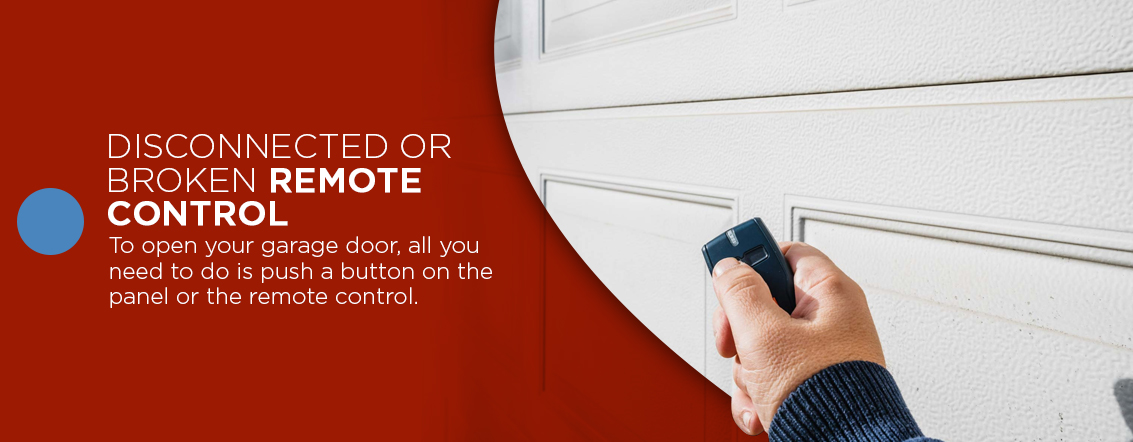
4. Disconnected or Broken Remote Control
An automatic garage door is controlled with either the wall-mounted panel or remote control. To open your garage door, all you need to do is push a button on the panel or the remote control. The remote control sends a signal to the garage door opener to open or close the garage.
If your garage door won't open, it's possible your remote control is broken. Here are some ways to troubleshoot your remote control:
- Get in range of the garage door: The sensor for your remote control may be out of range from the garage door. Get closer to the door and try using the remote.
- Fix the antenna: The antenna could be damaged, or the signal could be blocked. To ensure that your sensor is working, make sure the antenna is visible and hanging from the motor.
- Replace the battery: If the garage door opens by pressing the buttons on the wall-mounted panel, you may need to replace the batteries in the garage door remote control. Your remote control will either need a 3-volt lithium battery or a 12-volt battery. When you replace the battery, you might need to reset your remote.
- Reprogram the remote: The remote control needs to be programmed to your garage door system. Check the user manual for your remote control for reprogramming instructions.
- Install an app: You could put an app on your phone that connects to your garage door. With the ability to control the garage door from your phone, you won't need a remote control.
- Turn off the lock feature: If the light is blinking on your door control panel, press and hold down the "lock" button to turn off the lock feature. If you need to engage the lock feature again, you can hold down the "lock" button to turn it back on.
- Check the door control wiring: If the remote control and the wall-mounted panel respond, but your garage door won't open, inspect the wiring on your garage door's control. Unplug the opener and disconnect the two wires from the motor. Reconnect your machine to power and reprogram all remote controls. Test your garage door with the remote control.
If your remote garage door opener is lost or stolen, reset the garage's access code and erase the remote from memory. Resetting the access code prevents anyone that stole or found the remote from using it to enter your home. When you buy a replacement garage door remote, you'll have to program it with the new access code.
To replace your remote control for the garage door, look on the side of the door unit for a manufacturer's name and model number. Search for a new remote online or call your garage door manufacturer for a replacement. You could also purchase a universal remote garage door opener to be programmed to your garage.
Have Your Garage Inspected, Fixed or Replaced by Our Team at Door Pros
Why won't my garage door open all the way? Door Pros can help you figure out why your garage door won't open. Door Pros provides garage doors for San Mateo, San Rafael, Sacramento, San Francisco, Carmel and surrounding areas. We offer the following garage door services:
We also provide commercial garage door services to business owners who have garage doors in northern California. If you are experiencing difficulty with your garage door, contact us today to request an estimate or schedule service. For immediate assistance, you can call our Marin County office at 415-717-7015.

